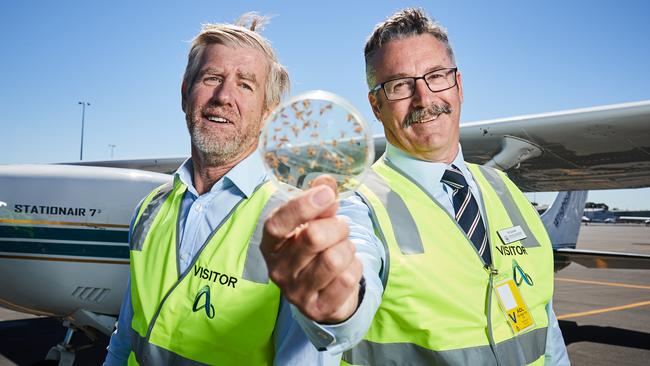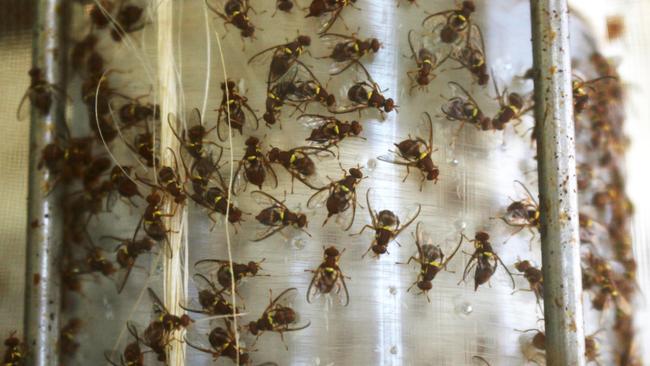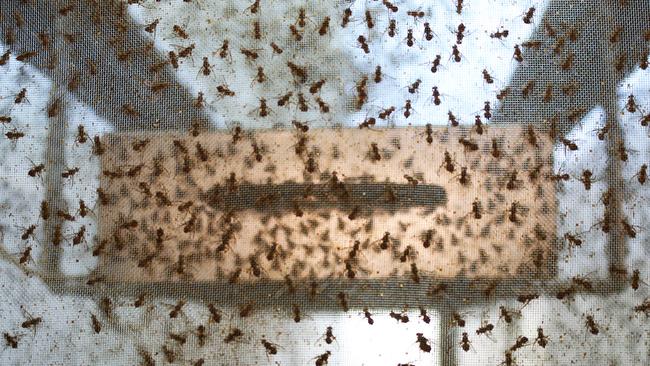Two million sterile fruit flies dropped by plane on Adelaide
TWO million of the most attractive but secretly sterile Queensland fruit flies have been air-dropped over Adelaide — in a new bid to protect a $1.1 billion industry.
SA News
Don't miss out on the headlines from SA News. Followed categories will be added to My News.
- An overflowing quarantine bin a real stinker for tourists
- Last month: 250,000 mangoes recalled after fruit-fly larvae found
- The ever-growing fruit fly threat to the Riverland
- How SA’s largest fruit fly outbreak in decade went undiscovered
- Keeping SA fruit fly free needs coordinated approach: Greg Barila
TWO million of the most attractive but secretly sterile Queensland fruit flies were released by plane over Adelaide on Tuesday in a new bid to protect the state’s $1.1 billion horticultural industry.
The air drop was focused on Woodville Park to ensure a ground baiting and trapping program eradicated a recent fruit fly outbreak that has the potential to devastate the state’s multimillion-dollar fruit and vegetable sector.
It is the first large batch of flies — bred to be the most attractive to potential wild mates with elite singing skills, smell, endurance, fitness, agility and looks — to be released from the sterile Queensland fruit fly facility opened in Port Augusta during 2016.

The aim is to attract any stray and fertile fruit flies in the suburbs to these sterile newcomers so they can ensure no offspring appear as flies die off.
Federal Agriculture Minister David Littleproud and the state’s new Agriculture Minister Tim Whetstone were on hand for at Adelaide Airport for the release.
Mr Littleproud said the National Sterile Insect Technology facility in Port Augusta currently produced about 30 million sterile Queensland fruit flies each week, increasing to about 100 million by 2019.

“This is a game changer for Australian horticulture, enabling farmers to reduce their pesticide use, expand their production of high quality crops free of Queensland fruit fly and capitalise on our trade wins,” Mr Littleproud said.
Careful consideration of wind conditions meant that the sterile flies were expected to land in the right zone, but backyard fruit and vegetable growers were warned to expect more pest activity in coming weeks.
Mr Whetstone said the sterile flies could be recognised by a coloured dye on their heads, adding that this was a “gamechanger” in ensuring the pests could be eradicated completely after the usual spraying and baiting.

SA is the only recognised mainland fruit fly-free state and last year, China joined other countries in recognising the Riverland as being fruit fly-free, boosting new market opportunities and slashing costs in expensive export treatment.
The Victorian, South Australian and Federal governments contributed to building the $3.8 million breeding facility overseen by Horticulture Innovation Australia.
HIA chief executive John Lloyd said researchers travelled to Austria, Spain, Israel, Guatemala, Mexico and the US to investigate leading operations to help with its design, with seven staff now on site.



